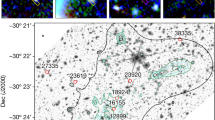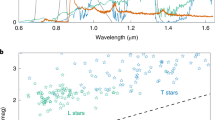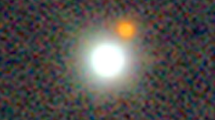Abstract
It has been known for decades that the observed number of baryons in the local Universe falls about 30–40 per cent short1,2 of the total number of baryons predicted3 by Big Bang nucleosynthesis, as inferred4,5 from density fluctuations of the cosmic microwave background and seen during the first 2–3 billion years of the Universe in the so-called ‘Lyman α forest’6,7 (a dense series of intervening H i Lyman α absorption lines in the optical spectra of background quasars). A theoretical solution to this paradox locates the missing baryons in the hot and tenuous filamentary gas between galaxies, known as the warm–hot intergalactic medium. However, it is difficult to detect them there because the largest by far constituent of this gas—hydrogen—is mostly ionized and therefore almost invisible in far-ultraviolet spectra with typical signal-to-noise ratios8,9. Indeed, despite large observational efforts, only a few marginal claims of detection have been made so far2,10. Here we report observations of two absorbers of highly ionized oxygen (O vii) in the high-signal-to-noise-ratio X-ray spectrum of a quasar at a redshift higher than 0.4. These absorbers show no variability over a two-year timescale and have no associated cold absorption, making the assumption that they originate from the quasar’s intrinsic outflow or the host galaxy’s interstellar medium implausible. The O vii systems lie in regions characterized by large (four times larger than average11) galaxy overdensities and their number (down to the sensitivity threshold of our data) agrees well with numerical simulation predictions for the long-sought warm–hot intergalactic medium. We conclude that the missing baryons have been found.
This is a preview of subscription content, access via your institution
Access options
Access Nature and 54 other Nature Portfolio journals
Get Nature+, our best-value online-access subscription
$29.99 / 30 days
cancel any time
Subscribe to this journal
Receive 51 print issues and online access
$199.00 per year
only $3.90 per issue
Buy this article
- Purchase on Springer Link
- Instant access to full article PDF
Prices may be subject to local taxes which are calculated during checkout




Similar content being viewed by others
References
Shull, J. M., Smith, B. D. & Danforth, C. W. The baryon census in a multiphase intergalactic medium: 30% of the baryons may still be missing. Astrophys. J. 759, 23 (2012).
Nicastro, F., Krongold, Y., Mathur, S. & Elvis, M. A decade of warm hot intergalactic medium searches: where do we stand and where do we go? Astron. Nachr. 338, 281–286 (2017).
Kirkman, D., Tytler, D., Suzuki, N., O’Meara, J. M. & Lubin, D. The cosmological baryon density from the deuterium-to-hydrogen ratio in QSO absorption systems: D/H toward Q1243+3047. Astrophys. J. Suppl. Ser. 149, 1–28 (2003).
Planck Collaboration. Planck 2015 results. XIII. Cosmological parameters. Astron. Astrophys. 594, A13 (2016).
Komatsu, E. et al. Five-year Wilkinson microwave anisotropy probe observations: cosmological interpretation. Astrophys. J. Suppl. Ser. 180, 330–376 (2009).
Rauch, M. The Lyman alpha forest in the spectra of QSOs. Annu. Rev. Astron. Astrophys. 36, 267–316 (1998).
Weinberg, D. H., Miralda-Escudé, J., Hernquist, L. & Katz, N. A lower bound on the cosmic baryon density. Astrophys. J. 490, 564–570 (1997).
Cen, R. & Ostriker, J. P. Where are the baryons? Astrophys. J. 514, 1–6 (1999).
Davé, R. et al. Baryons in the warm–hot intergalactic medium. Astrophys. J. 552, 473–483 (2001).
Bonamente, M. et al. A possible Chandra and Hubble Space Telescope detection of extragalactic WHIM towards PG 1116+215. Mon. Not. R. Astron. Soc. 457, 4236–4247 (2016).
Willmer, C. N. A. et al. The deep evolutionary exploratory probe 2 galaxy redshift survey: the galaxy luminosity function to z~1. Astrophys. J. 647, 853–873 (2006).
Cen, R. & Ostriker, J. P. Where are the baryons? II. Feedback effects. Astrophys. J. 650, 560–572 (2006).
Branchini, E. et al. Studying the warm hot intergalactic medium with gamma-ray bursts. Astrophys. J. 697, 328–344 (2009).
Schaye, J. et al. The EAGLE project: simulating the evolution and assembly of galaxies and their environments. Mon. Not. R. Astron. Soc. 446, 521–554 (2015).
Mernier, F. et al. Radial metal abundance profiles in the intra-cluster medium of cool-core galaxy clusters, groups, and ellipticals. Astron. Astrophys. 603, A80 (2017).
H.E.S.S. Collaboration. The 2012 flare of PG 1553+113 seen with H.E.S.S. and Fermi-LAT. Astrophys. J. 802, 65 (2015).
Nicastro, F. et al. Chandra detection of the first X-ray forest along the line of sight to Markarian 421. Astrophys. J. 629, 700–718 (2005).
Asplund, M., Grevesse, N., Sauval, A. J. & Scott, P. The chemical composition of the Sun. Annu. Rev. Astron. Astrophys. 47, 481–522 (2009).
Yoshida, N., Furlanetto, S. R. & Hernquist, L. The temperature structure of the warm–hot intergalactic medium. Astrophys. J. 618, L91–L94 (2005).
Danforth, C. W., Keeney, B. A., Stocke, J. T., Shull, J. M. & Yao, Y. Hubble/COS observations of the Lyα forest toward the BL Lac object 1ES 1553+113. Astrophys. J. 720, 976–986 (2010).
Danforth, C. W., Stocke, J. T. & Shull, J. M. Broad H I absorbers as metallicity-independent tracers of the warm–hot intergalactic medium. Astrophys. J. 710, 613–633 (2010).
Nicastro, F. et al. X-ray detection of warm ionized matter in the Galactic halo. Mon. Not. R. Astron. Soc. 457, 676–694 (2016).
Schaye, J. Model-independent insights into the nature of the Lyα forest and the distribution of matter in the Universe. Astrophys. J. 559, 507–515 (2001).
Brescia, M., Cavuoti, S., Longo, G. & De Stefano, V. A catalogue of photometric redshifts for the SDSS-DR9 galaxies. Astron. Astrophys. 568, A126 (2014).
Prochaska, J. X., Weiner, B., Chen, H.-W., Cooksey, K. L. & Mulchaey, J. S. Probing the IGM/galaxy connection. IV. The LCO/WFCCD galaxy survey of 20 fields surrounding UV-bright quasars. Astrophys. J. Suppl. Ser. 193, 28 (2011).
Reeves, J. N. et al. A high resolution view of the warm absorber in the quasar MR 2251-178. Astrophys. J. 776, 99 (2013).
Nicastro, F., Fiore, F., Perola, G. C. & Elvis, M. Ionized absorbers in active galactic nuclei: the role of collisional ionization and time-evolving photoionization. Astrophys. J. 512, 184–196 (1999).
Kruper, J. & Canizares, C. R. A sharp X-ray absorption feature in the BL Lac Object PKS 2155-304. Bull. Am. Astron. Soc., 14 933 (1982).
Madejski, G. M., Mushotzky, R. F., Weaver, K. A., Arnaud, K. A. & Urry, C. M. A ubiquitous absorption feature in the X-ray spectra of BL Lacertae objects. Astrophys. J. 370, 198–204 (1991).
Nicastro, F. et al. Chandra discovery of a tree in the X-ray forest toward PKS 2155-304: the local filament? Astrophys. J. 573, 157–167 (2002).
Fang, T., Sembach, K. R. & Canizares, C. R. Chandra detection of local O VII Heα absorption along the sight line toward 3C 273. Astrophys. J. 586, L49–L52 (2003).
Cagnoni, I., Nicastro, F., Maraschi, L., Treves, A. & Tavecchio, F. A view of PKS 2155-304 with XMM-Newton reflection grating spectrometers. Astrophys. J. 603, 449–455 (2004).
Bregman, J. N. & Lloyd-Davies, E. J. X-ray absorption from the Milky Way halo and the local group. Astrophys. J. 669, 990–1002 (2007).
Nicastro, F., Senatore, F., Krongold, Y., Mathur, S. & Elvis, M. A distant echo of Milky Way central activity closes the Galaxy’s baryon census. Astrophys. J. 828, L12 (2016).
Rasmussen, A. P. et al. On the putative detection of z > 0 X-ray absorption features in the spectrum of Mrk 421. Astrophys. J. 656, 129–138 (2007).
Fang, T., Buote, D. A., Humphrey, P. J. & Canizares, C. R. Detection of a transient X-ray absorption line intrinsic to the BL Lacertae object H 2356-309. Astrophys. J. 731, 46 (2011).
Krongold, Y. et al. The compact, conical, accretion-disk warm absorber of the Seyfert 1 galaxy NGC 4051 and its implications for IGM-galaxy feedback processes. Astrophys. J. 659, 1022–1039 (2007).
Krongold, Y. et al. Suzaku monitoring of the Seyfert 1 galaxy NGC 5548: warm absorber location and its implication for cosmic feedback. Astrophys. J. 710, 360–371 (2010).
Ackermann, M. et al. Multiwavelength evidence for quasi-periodic modulation in the gamma-ray blazar PG 1553+113. Astrophys. J. 813, L41 (2015).
Lehner, N. et al. The bimodality distribution of the cool circumgalactic medium at z ≲ 1. Astrophys. J. 770, 138 (2013).
Acknowledgements
This work is based on observations obtained with XMM-Newton, an ESA science mission with instruments and contributions directly funded by ESA Member States and NASA. F.N. and M.E. acknowledge support from NASA grant NNX17AD76G. S.M. acknowledges NASA grant NNX16AF49G. S.B. acknowledges financial support through agreement ASI-INAF n.2017-14-H.0 and an INFN INDARK grant. Y.K. thanks INAOE for the support offered during a sabbatical visit in 2017 and acknowledges support from grant DGAPA-PAPIIT 106518 and from programme DGAPA-PASPA. R.C. acknowledges support from NSF grant AST-1515389.
Reviewer information
Nature thanks R. Davé and T. Fang for their contribution to the peer review of this work.
Author information
Authors and Affiliations
Contributions
F.N. designed the study (together with J.K., L.P., S.B., L.Z., S.M., M.E., R.C., F.P. and A.G.), reduced and analysed the X-ray data, analysed the FUV data, extracted diagnostics by modelling the X-ray and FUV data and wrote the paper. Y.K., J.K., L.P., S.M., M.E., F.P., F.F. and A.G. helped with the analysis and modelling of the X-ray spectra. M.D. and F.N. designed and executed the Monte Carlo simulations used to evaluate the statistical significance of the absorbers. J.K. provided the most up-to-date XMM-Newton RGS calibrations and effective area corrections. C.W.D. and J.M.S. reduced the HST-COS data, extracted the G130 and G160 final spectra and helped with the interpretation of those spectra. Y.K. performed the optical photometric observations, as well as the reduction and analysis of those data, with the help of D.M. and D.R.-G. D.R.-G. and J.T.Z. provided the galaxies’ spectroscopic redshifts. S.B., E.B., J.S., N.W. and R.C. provided hydrodynamical simulations and general theoretical support to the results. In particular, J.S. and N.W. provided results from high-resolution Eagle simulations and F.P. helped to extract the number density of O vii absorbers from these simulations. All authors contributed equally to the discussion of the results and commented on the manuscript.
Corresponding author
Ethics declarations
Competing interests
The authors declare no competing interests.
Additional information
Publisher’s note: Springer Nature remains neutral with regard to jurisdictional claims in published maps and institutional affiliations.
Extended data figures and tables
Extended Data Fig. 1 XMM-Newton RGS spectra of 1ES 1553+113.
Broadband, unfolded RGS1 (black points; 1σ error bars) and RGS2 (red points; 1σ error bars) spectra (in bins with a signal-to-noise ratio per bin ≥20) and best-fitting models (black and red histograms) for the blazar 1ES 1553+113, in physical units. Blue arrows mark Galactic absorption lines; green and magenta arrows indicate absorption lines from our WHIM System 1 and System 2, respectively. FE, source flux (power per unit area and energy).
Extended Data Fig. 2 Normalized XMM-Newton RGS spectra of 1ES 1553+113.
Normalized raw RGS1 (black points; 1σ error bars) and RGS2 (red points; 1σ error bars) data (in bins with a signal-to-noise ratio per bin ≥30) of the blazar 1ES 1553+113, in the wavelength interval λ = 26−32 Å. Thick dashed curves are the RGS1 (black) and RGS2 (red) best-fitting models, folded through the response functions of the RGSs. Thin solid curves at the bottom of the graph are RGS1 (black) and RGS2 (red) effective areas (in arbitrary units), showing instrumental features due to cool pixels in the dispersing detectors. Of the five absorption lines shown, only the weak O vii Heβ at zX = 0.4339, and only in RGS1, can be affected by the presence of an instrumental feature.
Extended Data Fig. 3 Assessing systematic errors in the RGS spectrum of 1ES 1553+113.
Outcome of a Monte Carlo procedure consisting of 10,000 evaluations of the single-line statistical significance of an unresolved (that is, broadened to the instrument line spread function) Gaussian added to the best-fitting continuum-plus-line model of the RGS spectrum of 1ES 1553+113 (see Methods). At each run, the line position is frozen at a random position in the range 8–33 Å, and its EW is allowed to vary freely from negative (emission) to positive (absorption). The data distribution is symmetric but slightly flatter than the red curve that shows the expected normal distribution for a standard deviation of unity. The normal distribution that best fits our Monte Carlo results has a standard deviation of 1.15 (green curve).
Extended Data Fig. 4 Constancy of the z = 0.4339 O vii absorber.
a, b, RGS spectra of 1ES 1553+113 obtained in the 2015 (black) and 2017 (red) observations for 800 ks and 950 ks, respectively, centred around the O vii Heα (a) and Heβ (b) transitions of System 1. The two lines are consistent with no variability between the two epochs, within their 1σ errors (Extended Data Table 2).
Extended Data Fig. 5 Galaxy photometric redshifts.
Histogram of photometric redshifts of r′ > 23.5 galaxies within cylindrical volumes with base radii of 500 kpc at each redshift interval and a line-of-sight depth of Δz = 0.075 (at 1σ redshift accuracy), centred on the line of sight to the blazar 1ES 1553+113. The black curve is the average number of galaxies with r′ > 23.5 expected within the explored volumes at each redshift bin, based on the galaxy logN–logS from ref. 11 (where N is the number of galaxies with surface brightness ≥S and we use a common but conservative B−r′ = 1 for all galaxy types, where B is the galaxy’s B magnitude). Vertical dashed green and blue lines indicate the redshifts of System 1 and System 2, respectively.
Extended Data Fig. 6 r′ > 23.5 galaxies surrounding WHIM System 1.
OSIRIS-GTC mosaic (in band r′) of the 12′ × 12′ field surrounding the line of sight to 1ES 1553+113 (indicated by the magenta circle). Green circles have radii of 500 kpc and 1.75 Mpc at z = 0.4125. Thin yellow circles highlight the positions of galaxies with photometric redshift estimates within the z = 0.375–0.450 interval, whereas thicker circles highlight spectroscopic redshifts (solid, confirmed; dashed, unconfirmed).
Extended Data Fig. 7 r′ > 23.5 galaxies surrounding WHIM System 2.
Same as Extended Data Fig. 5, but for System 2, in the z = 0.300–0.375 interval.
Rights and permissions
About this article
Cite this article
Nicastro, F., Kaastra, J., Krongold, Y. et al. Observations of the missing baryons in the warm–hot intergalactic medium. Nature 558, 406–409 (2018). https://doi.org/10.1038/s41586-018-0204-1
Received:
Accepted:
Published:
Issue Date:
DOI: https://doi.org/10.1038/s41586-018-0204-1
This article is cited by
-
Portraying the missing baryonic mass at the cosmic noon: the contribution of CUBES
Experimental Astronomy (2023)
-
Scientific objectives of the Hot Universe Baryon Surveyor (HUBS) mission
Science China Physics, Mechanics & Astronomy (2023)
-
The CUBES science case
Experimental Astronomy (2023)
-
The Athena X-ray Integral Field Unit: a consolidated design for the system requirement review of the preliminary definition phase
Experimental Astronomy (2023)
Comments
By submitting a comment you agree to abide by our Terms and Community Guidelines. If you find something abusive or that does not comply with our terms or guidelines please flag it as inappropriate.



